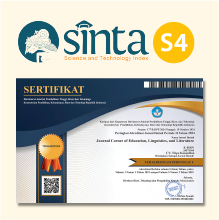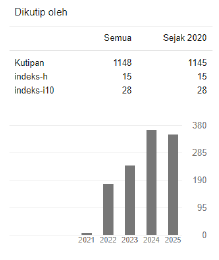The Intricateness of Adaptation of Literature to Film in Today’s Crisscrossed World
 https://doi.org/10.54012/jcell.v3i4.282
https://doi.org/10.54012/jcell.v3i4.282
 Abstract views: 1522
Abstract views: 1522
 PDF downloads: 744
PDF downloads: 744
Keywords:
adaptation, crisscrossed world, dialogues, interpretations, literary criticismAbstract
This paper investigates the realities of literature adaptation to film in today’s world of literary criticism. People enjoy motion pictures and compare them with its original textual Literature. By focusing on literary criticism theories, this article explains modern to postmodern aesthetic points, especially in the era of definitions in romanticism, reflectionism and its auto, empiricism until pragmatism, and the age of language beyond communication. Through those former points, the adaptation of Literature to film brings in a wider point: the world itself. The adaptation is shown to broaden concepts and interpretations among writers, directors, and also audiences. Every aspect is so active to interpret in today's crisscrossed world that meanings vary from critical and evaluation perspectives. The adaptation is not about merely fixed definitions or even market orientations but open meanings on dialogues among realities. Any measurement from Literature or film is never enough to compare adaptation to its original form since it is located between individualities and societies. In conclusion, the adaptation of Literature should indicate that dominations must be minimized by maximizing hospitality of differences.
Downloads
References
Agustina, A. (2015). Karya Adaptasi; Sebuah Pemiskinan atau Pengayaan Ide? Jurnal Institut Seni Indonesia Yogyakarta, 1-24.
Ardianto, D. T. (2014). Dari Novel ke Film: Kajian Teori Adaptasi sebagai Pendekatan dalam Penciptaan Film. Panggung, 24(1), 16-24.
Atherton, C. (2005). Defining Literary Criticism. New York, USA: Palgrave McMillan.
Deranty, J. (2015). Existential Aesthetics. plato.stanford.edu/entries/aesthetics-existentialist/.
Habib, M. (2005). History of Literary Criticism: From Plato to the Present. Oxford: Blackwell.
Hamdani, F. N., Marharendra, A. M., Kusuma, A. W., & Pasopati, R. U. (2023). The Intertwinements of Information and Literacy in Contemporary Culture. In Proceeding of International Seminar Enrichment of Career by Knowledge of Language and Literature (Vol. 11, No. 1, pp. 225-243).
Ita farida, S. (2007). Adaptasi dari Karya Sastra ke Film: Persoalan dan Tantangan. Masyarakat, Kebudayaan dan Politik, 20(2), 149 – 156
Litz, A. W., Menand, L., and Rainey, L. (eds.). (2008). The Cambridge History of Literary Criticism, New York: Cambridge University Press.
Nafsi, G., S, Hasanuddin W., & Zulfadhli, (2014), Ekranisasi Novel Cintaku Untuk Si Mata Indah Karya Sri Rokhati ke Film Habibie & Ainun Karya Sutradara
Faozan Rizal. Jurnal Bahasa dan Sastra Universitas Negeri Padang, 2 (3), 15-18.
Osborne, P. & Charles, M.. (2015). Walter Benjamin. plato.stanford.edu/entries/benjamin/.
Oza, P. (2024), Adaptation Theories In Literature – Shakespeare Into Film and Cinema, St. Andrew’s College, University of Mumbai, 1.
Pasopati, R. U. (2021). The Chronicles of Blame Culture in Digital Populism in Indonesia. In The 1st International Conference on Language Linguistic Literature and Education (ICLLLE).
Pasopati, R. U., Pujimahanani, C., & Azzahra, A. A. (2022). The Death of Expertise as Indicated through Donald Barthelme’s The Balloon. British (Jurnal Bahasa dan Sastra Inggris), 11(2).
Pial, T. Salim, S. Pethe, C. Kim, A & Skiena, S., (2023), Analyzing Film Adaptation through Narrative Alignment.
Rahmawati, R. D., Basuki, I., & Pujiati, H. (2013). Adaptation Analysis of Harry Potter and the Half-Blood Prince Novel by J.K Rowling into Film by David Yates. Artikel Hasil Penelitian Mahasiswa Universitas Jember, I (1), 1-5.
Rahmoun, O. (2020). Film Adaptation Between the Pride of Literature and the Prejudice of Inferiority, AWEJ for Translation & Literary Studies, Volume 4, Number 1.
Richards, I. A. (2001). Principles of Literary Criticism. London, England: Routledge.
Saepudin. (2012). Global-Lokal: Adaptasi Budaya Film Internasional. Makna FKSB Unisma, 3 (1), 28-43.
Saputra, H. S. P. (2009). Transformasi Lintas Genre: Dari Novel ke Film, Dari Film ke Novel. Humaniora, 21 (1), 41-55.
Seaton, J. (2014). Literary Criticism from Plato to Postmodernism: The Humanistic Alternative. New York: Cambridge University Press.
Shankarappa, S. S., (2022), The Critical Study of the Cinematic Adaptations of Chetan Bhagat’s Novels, Swami Ramanand Teerth Marathwada University, Nanded, 3.
Snyder, M. H. (2011). Analyzing Literature- to-Film Adaptations: A Novelist’s Exploration and Guide. New York: Continuum.
Souza, G. T. C. de, Schettini, F.; Pires, A., Forcatho, F.. (2023) From Literature to film, from film to series: some remarks on the intermedia/intersemiotic transit around itchcock’s Psycho, Revista Brasileira de Estudos de Cinema e Audio-visual.
Tiwahyupriadi, D., & Ayuningtyas, Y. (2020). Indonesian Horror Film: Deconstruction of Repetitive Elements of Indonesian Urban Legend for Cultural Revitalization, Creativity, and Critical Thinking. KnE Social Sciences, 4(12), 115–125.
Tolibovna, S. R. (2022), Noteworthiness of Film Studies and Adaptation in Literature.
Wartenberg, T. (2015). Philosophy of Film. plato.stanford.edu/entries/film/.
Yu, A. (2020). Discussion of the Artistic Aesthetic Transformation between Film and Literature from the Perspective of Adaptation, Journal of Language and Teaching and Research, Vol. 11, No. 6, pp 1005-1010.
Downloads
Published
How to Cite
Issue
Section
License
Copyright (c) 2024 Rommel Utungga Pasopati, Fransisca Irnidianis Magdalena Suyaji, Kheista Sasi Kirana, Riska Dewi Ramadhani, Kusuma Wijaya

This work is licensed under a Creative Commons Attribution-ShareAlike 4.0 International License.
All articles published in the Journal Corner of Education, Linguistics, and Literature are licensed under the Creative Commons Attribution-ShareAlike License (CC BY-SA).

















